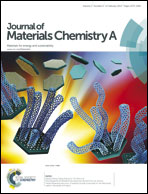N-doped titanate nanostructures on gradient surface layer of one dimensional nanofibers synthesized on Ti electrode by chemical and thermal treatments†
Abstract
TiO2 nanostructures have attracted much attention due to their semi-conductivity and photocatalytic properties, but are rarely used as functional electrodes for water electrolysis that requires high electrical conductivity. Compared to TiO2, a high doping level of N into titanates is expected due to their layered structure, which was attempted to improve the conductivity. Here, a surface layer of one dimensional hydrogen titanate (H-titanate) nanofibers with high surface area and poor crystallinity was synthesized on the surface of Ti metal by mild NaOH and HCl treatments, as compared to the commonly used severe hydrothermal treatments. The poorly crystallized structure of the layered H-titanate allowed the incorporation of a large amount of N into its surface layer by thermal treatments at 700 °C or more, thereby transforming it into Ti-oxynitrides with high electrical conductivity while retaining the high surface area of the treated layer. The depth profile analyses of the chemically and thermally treated Ti metal revealed that the concentration of O and H was the highest at the top surface of the surface layer. With increasing depth, the concentration of O and H decreased gradually whereas the concentration of N increased gradually, indicating gradients in the structures of the treated nanofibrous surface layer. The dense region below the nanofibrous surface layer was composed of Ti2N, whose amount increased with increasing temperature. This kind of gradient surface layer of N-doped titanate nanofibers without well-defined interfaces was synthesized on the surface of the Ti electrode by our unique chemical and thermal treatments and was modeled with varying depths. The specific objective of the present work is to characterize and study the mechanism of formation of the N-doped structures in a one dimensional gradient surface layer of H-titanate nanofibers synthesized on the treated Ti electrode. The treated one dimensional nanofibrous surface layer on a Ti electrode can be potentially used for the electro-splitting of water after fixation of molecular catalysts on its surface.


 Please wait while we load your content...
Please wait while we load your content...